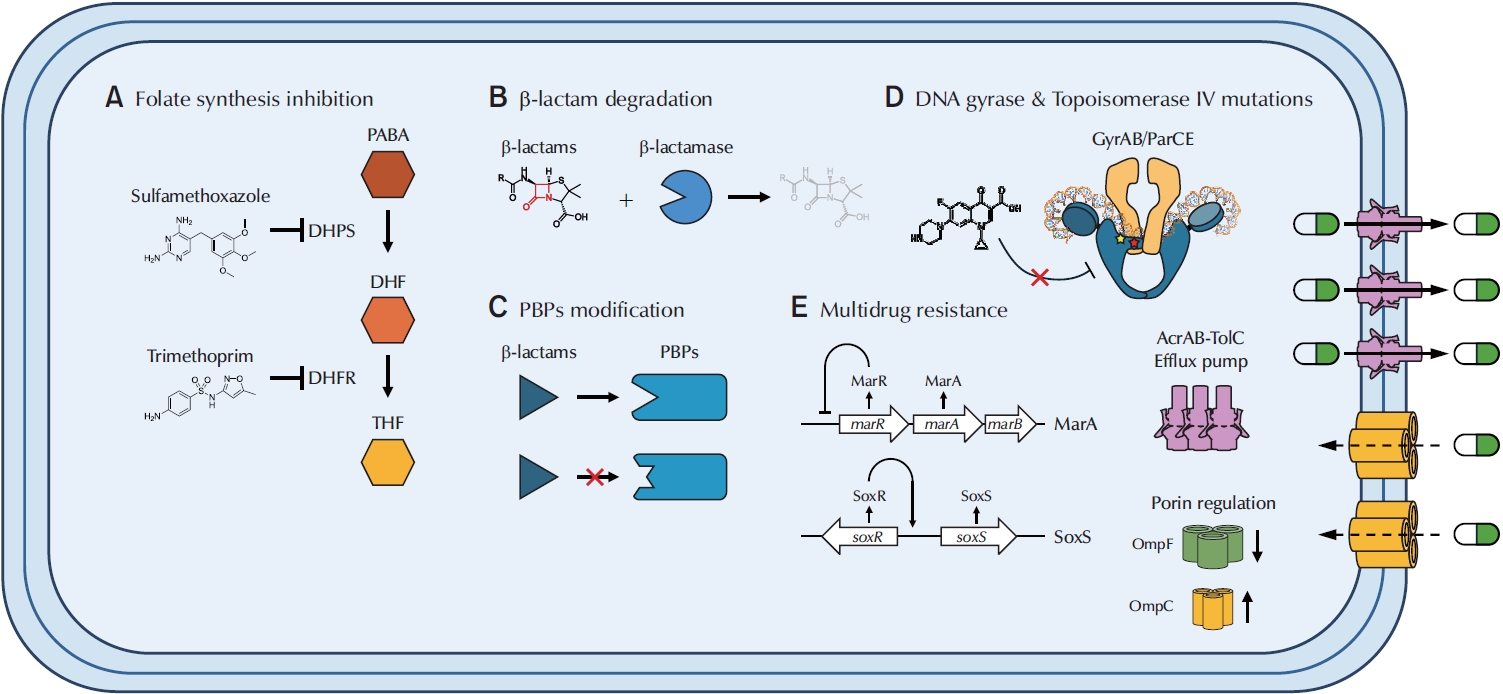Search
- Page Path
- HOME > Search
Review Articles
- Molecular Mechanisms of Antibiotic Resistance in Uropathogenic Escherichia coli: A Narrative Review
- Nakjun Choi, Dong Uk Kim, Eun-Jin Lee
- Urogenit Tract Infect 2025;20(2):96-106. Published online August 31, 2025
- DOI: https://doi.org/10.14777/uti.2550018009

-
 Abstract
Abstract
 PDF
PDF PubReader
PubReader - Urinary tract infections (UTIs) are among the most prevalent bacterial infections worldwide, with uropathogenic Escherichia coli (UPEC) serving as the primary causative agent. Although antibiotic therapy remains the standard of care for UTI treatment, the increasing prevalence of antimicrobial resistance has substantially reduced the effectiveness of commonly prescribed antibiotics. Resistance to trimethoprim-sulfamethoxazole (TMP-SMX), β-lactams, and fluoroquinolones is particularly concerning, as these agents constitute the principal therapeutic options for UTIs. This review examines the molecular mechanisms underlying UPEC resistance to these three classes of antibiotics, including target site modifications, efflux pump overexpression, porin regulation, and enzymatic degradation. Furthermore, it explores how these resistance determinants contribute to the development of multidrug-resistant (MDR) UPEC strains, which demonstrate cross-resistance to multiple antibiotics and present significant challenges for clinical management. Novel therapeutic strategies, such as efflux pump inhibitors, bacteriophage therapy, and genomic-guided precision medicine, are under investigation as potential solutions to address the growing global burden of MDR UPEC, alongside alternative non-antibiotic treatments. This review aims to provide a comprehensive overview of the genetic and regulatory pathways driving antibiotic resistance in UPEC, offering insights that may guide the development of effective treatment strategies and help mitigate the ongoing spread of antimicrobial resistance.
-
Citations
Citations to this article as recorded by- Editorial for Urogenital Tract Infection (UTI) 2025 Vol. 20 No. 2 – Highlights of This Issue’s Papers and the UTI Editors’ Pick
Koo Han Yoo
Urogenital Tract Infection.2025; 20(2): 55. CrossRef
- Editorial for Urogenital Tract Infection (UTI) 2025 Vol. 20 No. 2 – Highlights of This Issue’s Papers and the UTI Editors’ Pick
- 3,205 View
- 61 Download
- 1 Crossref

- Advances in the Diagnosis of Urinary Tract Infection: A Narrative Review
- Juan Victor Ariel Franco, Nicolás Meza
- Urogenit Tract Infect 2025;20(1):17-27. Published online April 30, 2025
- DOI: https://doi.org/10.14777/uti.2550020010

-
 Abstract
Abstract
 PDF
PDF PubReader
PubReader ePub
ePub - Urinary tract infections are among the most frequent bacterial infections, significantly impacting patient morbidity and healthcare resources. Prompt and accurate diagnosis is crucial to ensure effective treatment, prevent complications such as pyelonephritis or sepsis, and reduce inappropriate antibiotic use, contributing to antimicrobial resistance (AMR). Despite consensus across international guidelines from organizations, challenges persist, particularly in distinguishing true infections from asymptomatic bacteriuria or nonspecific symptoms, especially in older adults. Recent advancements in diagnostic technology have emerged to address these limitations, including molecular diagnostics, point-of-care testing (POCT), and artificial intelligence (AI)-driven predictive models. Molecular techniques, notably polymerase chain reaction, loop-mediated isothermal amplification, and metagenomic next-generation sequencing, offer enhanced sensitivity and specificity, rapid detection times, and comprehensive identification of pathogens and resistance profiles. POCT innovations, such as lateral flow immunoassays, enzymatic-based rapid tests, and novel biosensors, facilitate prompt bedside diagnosis, although specificity challenges remain. Meanwhile, AI and machine learning models demonstrate significant potential for risk stratification, prediction of infection, and improving antibiotics prescription practices yet face barriers related to validation, practical integration, and clinical acceptability. Despite promising developments, significant gaps remain, including limited real-world implementation evidence, high costs, and insufficient data from diverse populations. Further rigorous clinical studies, economic evaluations, and practical implementation assessments are urgently required. Addressing these research gaps could substantially improve patient outcomes, optimize antibiotic stewardship, and reduce the global burden of AMR.
-
Citations
Citations to this article as recorded by- Editorial for UTI 2025 Vol. 20 No. 1 - Highlights of This Issue’s Papers and the UTI Editors’ Pick
Koo Han Yoo
Urogenital Tract Infection.2025; 20(1): 1. CrossRef
- Editorial for UTI 2025 Vol. 20 No. 1 - Highlights of This Issue’s Papers and the UTI Editors’ Pick
- 7,304 View
- 225 Download
- 1 Crossref

Original Article
- Changes of Causative Organism and Antimicrobial Resistance in Urinary Tract Infections After the COVID-19
- Young Ho Choi, Jong Hyun Tae, Mi-Kyung Lee, Tae-Hyoung Kim
- Urogenit Tract Infect 2022;17(2):42-49. Published online August 31, 2022
- DOI: https://doi.org/10.14777/uti.2022.17.2.42
-
 Abstract
Abstract
 PDF
PDF PubReader
PubReader ePub
ePub - Purpose: During the coronavirus disease 2019 (COVID-19) pandemic, several studies reported changes in the distribution of microorganisms that cause major legal, respiratory, and gastrointestinal infectious diseases and increases in the antimicrobial resistance rates in Korea. On the other hand, there has been little domestic research on the causative organism of urinary tract infection (UTI). This study investigated the influence of the COVID-19 pandemic on the distribution of causative organisms and the antimicrobial resistance rate in UTI.
Materials and Methods: This study analyzed 17,201 urine cultures retrospectively from patients who visited Chung-Ang University Hospital from January 2018 to December 2021. Tests were then conducted to determine if there was a significant difference between the data for the eight quarters of the pre-COVID-19 period (January 2018 to December 2019) and the data for the eight quarters post-COVID-19 period (January 2020 to December 2021).
Results: Escherichia coli was the most common causative organism in all periods, but it decreased in the post-COVID-19 period. Enterococcus faecalis increased in the post-COVID-19 period. The ciprofloxacin resistance rate of E. coli and Klebsiella pneumoniae increased, but the ciprofloxacin and levofloxacin resistance rate of E. faecalis decreased.
Conclusions: There was little difference in the causative organism distribution of UTI and antimicrobial resistance rates before and after the COVID-19 pandemic. On the other hand, changes in some causative organisms are identified. Nevertheless, because this study was limited to a single medical institute, data from a broader spectrum of bacterial species collected from multiple institutions will be needed to obtain definitive results.
- 885 View
- 4 Download


 KAUTII
KAUTII

 First
First Prev
Prev


